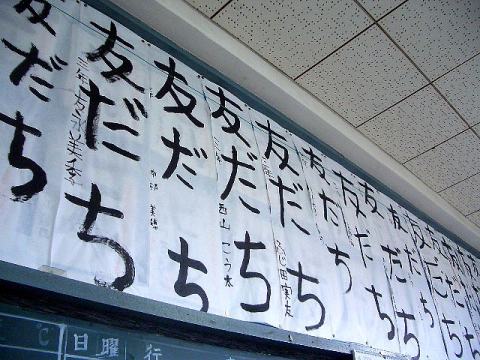
 |
| Calligraphy by children |
|---|
| Photo credit: Kanko* / CC licence |
The Japanese education system is a three-part system which begins at age six, and usually continues to age eighteen. Children attend elementary school, shōgakkō (小学校), for six years, starting at age six. From age twelve, they attend three years of junior high school, chūgakkō (中学校). On graduating from junior high school, they may attend high school, kōtōgakkō (高等学校), informally known as kōkō (高校). School years begin in April, and the child's school year is determined by his or her age on April 1.
Children begin officially learning reading and writing at the age of six, when they enter elementary school. They learn hiragana and katakana during the first year of elementary school. (See Hiragana and katakana for more about these.) They may already be able to read hiragana and katakana, but this is not part of the official curriculum.
One thousand and twenty-six kanji (Chinese characters, see Kanji for more about them) are learnt over the six years of elementary school. The kanji are divided into six one-year grades of 80, 160, 200, 197, 197, and 192 characters. These grades are commonly known as the kyōiku kanji (教育漢字) or gakushū kanji (学習漢字), but their official name is Gakunenbetsu Kanji Haitōhyō (学年別漢字配当表).[1][2] This means "List of kanji by school year".
The rest of the Jōyō and Jinmei kanji (see What are the Jōyō Kanji? and How many kanji are there?) may be taught at junior high or high school level, and further non-Jōyō kanji may be taught at high school level. There is no set list of grades for the Jōyō kanji of junior high school or high school.
Children learn calligraphic writing using a brush in the kaisho form (see Handwritten styles) during their third year of school. Many children also study penmanship or calligraphy, shūji (習字), outside school.
Romanized Japanese using the Kunrei system (see What are the systems of romanization of Japanese?) is taught in the fourth year of elementary school.[3]
Twenty kanji were added to the list of characters to be taught in elementary school in 2020.[4] These characters are the kanji for the names of Japan's prefectures which are not already in the list. (See How does the Japanese addressing system work? for more on prefectures.) The names of the prefectures were taught to children in the fourth year of elementary school, but until 2020, since not all of the kanji were taught, furigana was used. (See What is furigana? for more about furigana.)
Copyright © 1994-2025 Ben Bullock
If you have questions, corrections, or comments, please contact Ben Bullock or use the discussion forum / Privacy policy

|

|

|

|

|
| Book reviews |
Convert Japanese numbers |
Handwritten kanji recognition |
Stroke order diagrams |
Convert Japanese units |